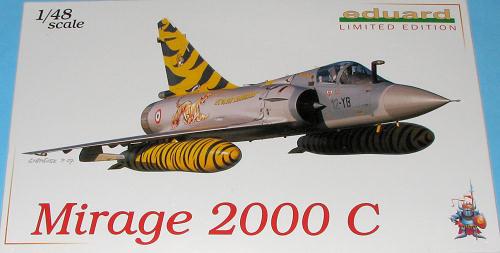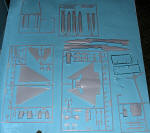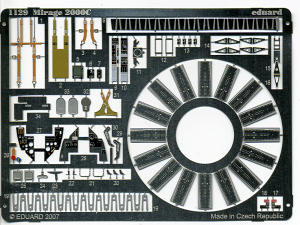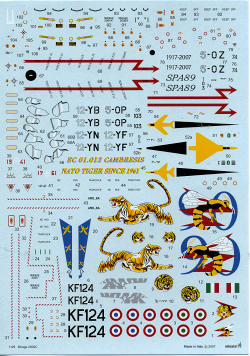
Eduard 1/48 Mirage 2000C
| KIT #: | 1129 |
| PRICE: | $54.00 MSRP |
| DECALS: | options |
| REVIEWER: | Scott Van Aken |
| NOTES: | Repackaged Heller kit with extras |

| HISTORY |
The Avion de Combat Futur (ACF) (French: "Future combat aircraft") was developed for the French Air Force in the early 1970s. After the ACF was canceled on 18 December 1975 due to its growing cost and complexity, Dassault offered the Mirage 2000 as an alternative. This was a return to the first generation Mirages, but with several important innovations that tried to solve their shortcomings. Project chiefs were B.C. Valliéres, J.Cabrière, J.C. Veber and B.Revellin-Falcoz.
Development of this small aircraft would also give the company a competitor to the General Dynamics F-16 Fighting Falcon, which had defeated the Dassault Mirage F1 in a contest for a new fighter for the air forces of Belgium, Denmark, Netherlands and Norway. Small single-engined fighters were clearly the most appreciated by foreign customers, as experience with the larger, twin-engined Mirage 4000 would show.
The prototype made its first flight in 10 March 1978 with test pilot Jean Coreau at the controls. Despite the new technologies applied, basing the new aircraft on the Mirage III allowed the development of a flyable prototype in only 27 months from the program start to the first flight, even if active service status needed another six years.
In that summer, at the Farnbourgh airshow, this machine displayed not only excellent handling capabilities, but also a full control at 204 km/h and 26 Angle of Attack. This was totally unexpected in a delta-wing fighter, and proof how CCD controls were capable of overcoming the delta wing shortcomings related to poor low-speed control, while retaining the advantages, such as low-drag, low RCS, ideal high speed aerodynamics and simplicity, provided by the absence of horizontal tail surfaces. The Mirage 2000 was one of the stars of that airshow and became the direct adversary for the F-16, which shared the CCD control and relaxed stability. The 02 Prototype followed in 18 September 1978 and 03 in 26 September 1979. After 400 hours of flight, they were sent to CEV (Centre Experimental du Vol). The 04 Prototype was a demonstrator made by Dassault for its own purposes, and finally the first dual-seat M.2000B flew in 11 October 1980.
The first production example flew on 20 November, 1982 and the aircraft went into operational service in 1984. They were practically pre-production aircraft, because they had no SARH missiles (RDM-1 radar) and the first model of SNECMA 'Super Atar'. M-53-2. The last Mirage 2000 was delivered on 23 November 2007.
The Mirage 2000 is scheduled to be replaced in French service by theDassault Rafale, which became operational with the French Air Force on 27 June 2006. The Mirage 2000 production line was shut down in November 2007 after the last aircraft had been delivered to the Hellenic Air Force.
| THE KIT |
 Eduard has been known in the past to rebox other kits, add their aftermarket bits and provide it to the buying public. This is one of those kits.
Eduard has been known in the past to rebox other kits, add their aftermarket bits and provide it to the buying public. This is one of those kits.
The base kit is the Heller 1/48 Mirage 2000C, by all accounts, the best one in this scale on the market. It is quite typical of Heller/Airfix 1/48 kits from a few years back. Engraved panel lines that are a bit on the soft side of things, but otherwise well done. By 'soft' I mean that the edged of the engraved parts are not crisp, 90 degree corners but are somewhat rounded.
 In addition to the base kit, there are resin parts for the bang seat and for the centerline tank, items that are not included in the kit or are poorly molded. A set of canopy and wheel masks is also included. These masks are also for doing some of the box art paint scheme; particularly that area just aft of the cockpit section. A color photo etch set provides detail for the cockpit, seat and some external pieces, particularly the jet pipe and afterburner. It would not be unrealistic to state that the majority of this set is for the latter.
In addition to the base kit, there are resin parts for the bang seat and for the centerline tank, items that are not included in the kit or are poorly molded. A set of canopy and wheel masks is also included. These masks are also for doing some of the box art paint scheme; particularly that area just aft of the cockpit section. A color photo etch set provides detail for the cockpit, seat and some external pieces, particularly the jet pipe and afterburner. It would not be unrealistic to state that the majority of this set is for the latter.
Getting back to the kit itself, it provides a nicely done cockpit tub and the wheel wells are sufficiently deep for most, though with no detailing at all, so you that like to stretch sprue or bend wire will have a clean slate on which to work. Interestingly, the fin/rudder is no molded on the fuselage half so will be a separate construct. A separate windscreen and canopy are given. This will allow you to pose it open. No actuating mechanism is shown. For things under wings you have a pair of large fuel tanks as well as a set of medium and short range air to air missiles. If you use the fuel tanks, that takes the space where the medium range missiles would have gone.
Instructions are superbly done with Gunze paint references. In addition to the usual parts layout and construction illustrations, the back page of the booklet includes paper templates for the tiger tail used in the initial option. The decal sheet is superbly done 'in Italy' which means Cartograf. The colors are vibrant and one should not worry about transparency. A full set of data markings is included. A large, 8 page markings and color booklet provides for the 6 options. The back of the booklet is a full stencil placement guide with the preceding page showing the painting of the tiger markings on the wing tanks and use of the masks.
Option 1 is, of course, the box art plane of EC 1/12 in Tiger Meet markings. Unless otherwise mentioned, all these are in the standard three color greys used by the French Air Force. Next is a 90th anniversary plane, also from EC 1/12. In a desert camouflage used by some aircraft during desert storm, is an EC 2/5 plane. Reverting back to standard camo and standard markings is another EC 1/12 aircraft. Next from EC 2/5 is one with a blue fin marking. The last is an Indian Air Force plane and here, I think the decal sheet has made a goof. They have printed what should be saffron (orange) in the insignia with a red, making these markings unusable without replacement insignia.
| CONCLUSIONS |
OK, so is it worth $54.00 retail? I'd say not as the local hobby shop got in three and there are still two left after well over a year. Sure, you get a lot of upgrade bits and a super decal sheet, so it is not a rip-off, just not the value that some expected. I got mine second had for the princely sum of $15 at a swap meet, else I'd not have this one to share with you.
| REFERENCES |
January 2009 If you would like your product reviewed fairly and fairly quickly, please contact the editor or see other details in the